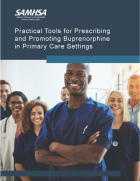Dashboard: Filter Bricks
Main page content



This brief report presents self-reports of recovery among adults aged 18 and older in the United States who thought they ever had a problem with their use of drugs or alcohol and/or mental health. These findings provide a clearer characterization of the factors associated with recovery among adults and how future efforts can foster a whole-health approach to sustain recovery from mental health and substance use conditions.

This document updates SAMHSA’s 2018 document and outlines best practices for the implementation and operation of recovery housing. These best practices are intended to serve as a tool for states, governing bodies, providers, recovery house operators, and other interested stakeholders to improve the health of their citizens, reduce incidence of overdose, and promote recovery housing as a key support strategy in achieving and sustaining recovery.

This guide offers information and tips to disaster responders and first responders to help them manage stress during crisis response. It describes how stress affects the body and suggests ways for individuals and organizations to promote and engage in stress management.

This resource provides information to primary care providers and practices on how to implement opioid use disorder treatment using buprenorphine. It identifies common barriers and strategies to overcome them. It documents step-by-step tactics to support buprenorphine implementation.

This wallet-size card includes the national Disaster Distress Helpline and lists warning signs of distress. It encourages those experiencing signs of psychological stress to call or text the helpline for support.

This brochure features the national Disaster Distress Helpline, which supports people who are coping with the after effects of a disaster. Learn about a disasters’ potential to cause psychological stress, warning signs of distress, and tips for coping.

The Executive Summary of this Treatment Improvement Protocol provides an overview on the use of the three Food and Drug Administration-approved medications used to treat opioid use disorder—methadone, naltrexone, and buprenorphine—and the other strategies and services needed to support recovery.

This Treatment Improvement Protocol (TIP) reviews the use of the three Food and Drug Administration (FDA)-approved medications used to treat OUD—methadone, naltrexone, and buprenorphine—and the other strategies and services needed to support recovery for people with OUD. This is a revision.
Displaying 1 - 10 out of 164

